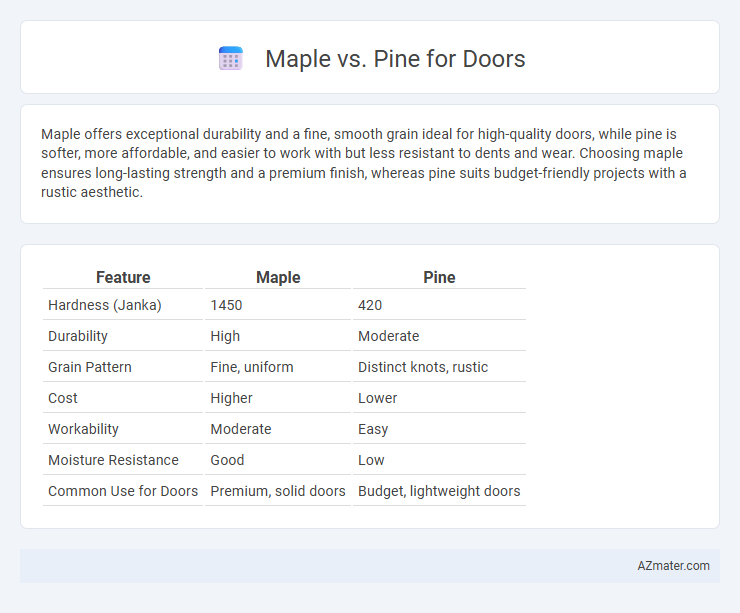Maple offers exceptional durability and a fine, smooth grain ideal for high-quality doors, while pine is softer, more affordable, and easier to work with but less resistant to dents and wear. Choosing maple ensures long-lasting strength and a premium finish, whereas pine suits budget-friendly projects with a rustic aesthetic.
Table of Comparison
| Feature | Maple | Pine |
|---|---|---|
| Hardness (Janka) | 1450 | 420 |
| Durability | High | Moderate |
| Grain Pattern | Fine, uniform | Distinct knots, rustic |
| Cost | Higher | Lower |
| Workability | Moderate | Easy |
| Moisture Resistance | Good | Low |
| Common Use for Doors | Premium, solid doors | Budget, lightweight doors |
Introduction: Maple vs Pine for Door
Maple and pine are popular wood choices for doors due to their distinct characteristics and cost differences. Maple offers a dense, durable, and fine-grained surface ideal for high-traffic areas, providing excellent resistance to dents and scratches. Pine is softer and lighter, featuring a rustic appearance with visible knots, making it more affordable but less resistant to wear over time.
Key Differences Between Maple and Pine
Maple doors are known for their exceptional hardness and durability, making them ideal for high-traffic areas, while pine doors offer a softer texture and are more prone to dents and scratches. Maple features a fine, consistent grain pattern with a pale, creamy color that can be easily stained to mimic more expensive woods, whereas pine has a distinct, knotty appearance with a warm yellow hue that often highlights its natural rustic character. Cost differences are notable; maple doors tend to be more expensive due to their density and longevity, while pine doors provide a budget-friendly option with quicker installation and easier customization.
Appearance and Grain Patterns
Maple doors showcase a smooth, consistent grain pattern with subtle, light-colored tones, offering a clean and elegant appearance ideal for modern and traditional interiors. Pine doors feature prominent knots and a more rustic, varied grain, providing a warm, natural look preferred for country-style or cottage designs. The choice between maple and pine depends largely on desired aesthetics, with maple delivering refined uniformity and pine offering character through its distinctive grain patterns.
Durability and Hardness Comparison
Maple wood is known for its high density and exceptional hardness, making it highly resistant to dents and scratches, which ensures long-lasting durability for doors. Pine, being a softer wood with lower Janka hardness, is more prone to dents and wear over time, requiring more frequent maintenance. For doors where durability and resistance to impact are critical, maple is generally the superior choice compared to pine.
Cost and Affordability
Maple doors typically cost more due to their dense grain and durability, making them a long-lasting investment that justifies the higher price. Pine doors are more affordable upfront, offering a budget-friendly option with a softer wood that is easier to work with but may require more frequent maintenance. Choosing between maple and pine hinges on balancing initial cost against potential durability and maintenance expenses.
Workability and Ease of Finishing
Maple wood offers superior workability with its dense grain, allowing for smooth cutting and sanding, making it ideal for detailed door designs. Pine is softer and easier to carve but may dent more easily, requiring careful handling during installation. When it comes to finishing, maple's tight grain absorbs stains evenly for a polished look, while pine's resinous nature can cause blotchy finishes unless properly sealed.
Resistance to Moisture and Decay
Maple doors offer moderate resistance to moisture and decay but can be prone to warping in highly humid environments without proper sealing. Pine doors are more susceptible to moisture damage and decay due to their softer grain and higher resin content, requiring frequent maintenance and treatment. For environments with significant moisture exposure, maple doors generally provide better durability and longevity compared to pine.
Suitability for Interior and Exterior Doors
Maple is ideal for interior doors due to its smooth grain, durability, and ability to take paint and stain well, providing a refined aesthetic in controlled environments. Pine, being softer and more prone to dents, suits interior doors where affordability and rustic charm are prioritized but generally lacks the weather resistance required for exterior use. For exterior doors, pine must be treated and sealed extensively to prevent warping and decay, whereas maple is less commonly used outside due to its susceptibility to moisture damage unless properly finished.
Maintenance and Longevity
Maple doors offer superior durability and resistance to dents and scratches, requiring minimal maintenance over time compared to pine. Pine is softer and more prone to wear, necessitating frequent sealing or painting to prevent moisture damage and extend its lifespan. Selecting maple ensures a longer-lasting door with less upkeep, ideal for high-traffic areas and climates with varying humidity.
Final Verdict: Choosing the Best Wood for Your Door
Maple offers a smooth, hard, and durable surface ideal for doors requiring high resistance to dents and wear, making it perfect for homes with heavy traffic. Pine, a softer wood with a distinctive grain and lighter weight, provides a more affordable and easier-to-work-with option but may dent and scratch more easily over time. For exterior doors demanding long-lasting strength and minimal maintenance, maple is the superior choice, while pine suits budget-conscious projects or decorative interior doors.

Infographic: Maple vs Pine for Door
 azmater.com
azmater.com